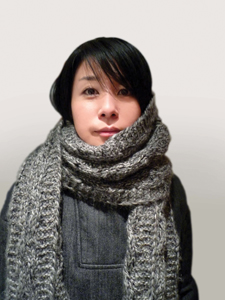Miyake Mai : Breaking Bad with Japanese Traditions
by Ry Beville
|
No other young artist in Japan has adapted and reinterpreted the native art tradition with as much devotion, insight and creativity as Miyake Mai. Her easily recognizable body of work, many pieces of which now occupy private and institutional collections, can seem on first glance like pop-culture renditions of old themes and motifs. But, as she warns, “Look closely, or the important things will slip away.” God is in the details, they say. With Miyake’s work, shrewd commentary on life, art, tradition and society reside in those details. Not everyone will see the same things. Most, however, will see why she is attracting such well-deserved attention. Even without knowledge of the traditions from which she works, viewers can recognize a clever, restless mind with a penchant for both mischief and beauty. Miyake is cheerful and full of effervescent energy when she talks. The typically bright colors of her work, with shadows and darker tones to pull them out, reflect her personality. Her affability and obvious consciousness of the world challenge typical notions of the eccentric artist. She’s also completely fluent in English from having lived in Australia as a child, and speaks some French from a brief tenure in Paris as an artist in residence later in life. Her studio occupies a quiet suburb of western Tokyo and features an entire wall of books. Art-related books comprise much of her library, including a sizable collection of manga, but there are other genres indicating an interest in subjects beyond her professional element, especially literature. Miyake is actually a published novelist and poet, too. She is quite comfortable with words, eloquent whether speaking in Japanese or English, and describes her basic process with illuminating examples. “Take the phrase shuriha (守離破, sometimes written shuhari). Shu, to protect, refers to honoring and protecting, as in the tradition. Ri, to separate, is like a child that must eventually part from his parents. Ha, is to break. I believe you have to scrap and rebuild things to make them stronger, including tradition. A lot has to do with origins, too. I think originality derives from your origins and you should work with that. I’m Japanese, so I use my contemporary world to rejuvenate our tradition.” Japanese aesthetic tradition has bequeathed to Miyake rich materials for reworking. Hanging scrolls are a conspicuous feature of her work. “Japanese are sensitive to the seasons, as reflected even in things like delicacies. Changing scrolls to suit seasons, your feelings or a particular guest that might be visiting was once common. Why have one framed picture on your limited wall space when it’s easier to have scrolls?” Calligraphy sometimes adorns images on scrolls but is largely absent from Miyake’s work. “Written scrolls are for tea ceremony, which is a very rigid tradition. I don’t believe in that. You have to breathe life into tradition, and tea ceremony doesn’t match the contemporary world.” Miyake’s scrolls would be blasphemous to a tea master. In “God of Wisdom” (知識の神), a fairly traditional rendering of the god with his egg-plant shaped head appears in the bottom left corner, but let your eyes float upward and toward the top is the Google logo and search bar. The conceit in many of her other scrolls is often more subtle, so much so that if the scroll were to hang in some formal setting–such as a tea room–guests might not even look closely enough to realize that some story is at work, which may even be poking fun at the world. There’s nothing cynical about her art, though. A deep sensitivity to our fragility, dreams and illusions seems to inform many pieces. Images and motifs adapted from Nihonga (“Japanese-style paintings”) take on a fairy-tale quality as if the “contemporary world” Miyake so often invokes begs for imaginative escape. Rich use of symbolism tempers some of the piercing observations of life, too, lending layers of meaning. Layers are equally important in the physical presentation. Her work is three-dimensional and exploits materials to create pieces that you don’t simply look at, but experience. Some of her art you look through, others you walk around, and different perspectives yield new revelations. Recently, she has been working on angled pieces that require the viewer to be in exactly the right spot for the full picture to come into view. “We’re all bees in a beehive, adding to the nest,” she says of the artistic endeavor, using a physical metaphor. And in her art, she is also always physically building. The industriousness of bees further speaks to the enormous body of work she has produced, despite her young age. But all this tangibility is an empty shell without her ideas and inspiration. That of course comes from tradition and the contemporary world. And maybe some quiet spark she carries within. |
日本の若手アーティストの中でも特に強い情熱を感じさせ、深い洞察力と創造性を持って日本美術の伝統をユニークな視点で解釈し提示しているのがミヤケマイである。一見して彼女の作品と分かるユニークな作品群は現在、個人や団体のコレクションの対象として人気が高い。古典的なテーマのポップカルチャー的演出、といった感じに見えるが、それについて彼女は「よく見ないと肝心なところを見逃すかも」と警告する。神は細部に宿る、という諺通り、ミヤケの作品の場合、生命、芸術、伝統、社会といったテーマに対する鋭い解釈が見落としがちな細部に宿っている。人によって見え方は異なるだろうが、よく見れば大概の人にはなぜ彼女がそんなに注目されているのか、その理由が分かるに違いない。彼女が題材として取り上げるテーマについて詳しく知らなくても、茶目っ気と美に対する強いこだわりを持った彼女の巧妙ともいえる知性を感じ取ることができるはずだ。 ミヤケは明るいキャラクターの持ち主で、熱い口調が印象的。作品も彼女の人柄を反映して全体的に明るい色調が特徴で、明るさを引きたてるために陰影も効果的に使われている。愛想の良さと世界に対する大きな意識が型破りな芸術家ならではの創造性の源になっている。小さい頃にオーストラリアに住んでいた経験から英語も堪能で、作品制作のためにパリに招聘された経験からフランス語も少し話す。 彼女のスタジオは東京の西の郊外の静かなところにあり、スタジオ内部の壁は書籍で埋めつくされている。芸術関係の学術書が大部分だが、漫画もかなりある。優れた文学作品などもあり、彼女の興味の幅広さが見える。実は彼女自身、本も出している小説家であり、詩人でもあるのだ。語彙も豊富だし日本語で喋っても英語で喋っても表現が豊かである。例を挙げながら彼女の基本的なプロセスについて説明してくれた。 「守離破(しゅりは)という言葉があります。守は伝統に則って教えを守ること、離は子供がやがて親離れしていく様子に例えられ、破は例えば伝統をより強固なものにしてゆくためにはそれを一度破ってまた統合するという工程が必要、ということです。ルーツにも大いに関係があります。独自性というものはその人のルーツから生まれるものだと思います。私のルーツは日本人ですから私ならではのコンテンポラリーな世界を駆使して日本の良き伝統を甦らせるために頑張っています」。 日本の美しき伝統はミヤケのためにたくさんの題材を残してくれている。掛軸もその一つである。 「日本人は季節に敏感で、その季節ならではの食材を楽しんだりします。季節やその時の気分、どんな訪問客が来るのかなどに応じて掛軸を変えることが昔は普通に行なわれていました。床の間の限られたスペースの壁には額よりも掛軸が好都合です」。 書も掛軸の題材となることが多いが三宅の作品にはそれは当てはまらない。 「書の掛軸は茶道で使うものとされていて、それは昔からの厳格な伝統なのです。私はそのような厳格さを正しいとは思いません。伝統は新風を吹き込みながら活性化を図るべきものだというのが私の考えです。厳格で型にはまることを要求する茶道は私が追求するコンテンポラリーな世界とは別世界のものだと考えています」。 ミヤケの掛軸を茶道に持ち込むことは茶道の先生にとっては不敬となろう。“知識の神”と名付けられた作品ではナスの形をした頭部を持った神が掛軸の左下の方に描かれているが、上の方に目をやるとGoogleのロゴと検索バーが目に入る。彼女の掛軸の特徴である奇抜な表現は巧妙に考えられた結果なので、茶室のようなフォーマルな場所で使われた場合、誰もその巧妙な表現に気付くことさえないかもしれない。そのフォーマルなシーンを密かにからかっているかのようだ。 とはいえ、彼女の芸術に、観る者を軽んじるようなところがあるわけではない。私たちが持つ弱さ、理想、空想といったものに対する鋭い感性が彼女の作品を生き生きとしたものにしている。日本画からヒントを得たイメージやモチーフはおとぎ話のワンシーンのようでもあり、彼女がしばしば口にするコンテンポラリーな世界が想像力豊かな現実逃避を要求しているかのようでもある。象徴的なイメージの多用は彼女の人生観の辛辣さが表に出過ぎることを多少なりとも和らげる役割を果たしている。 意味合いに多重性を持たせていることはプレゼンテーションにおいても重要である。彼女の作品には立体感があり、作品を構成する素材の持ち味をうまく引き出すことにより、単に観るだけでなく身体で感じるような作品に仕上げている。じっと観るためだけの作品もあれば、ぐるりと作品の周囲を回らせるようなものもあり、別の視点から観ることでまた別のものが見えてくる。最近彼女が取り組んでいる歪んだ絵では、鑑賞者は正しい位置に立たなければ絵の全体を正しく見ることが出来ないようになっている。 「私たちは巣箱に群がるミツバチのような存在です」と彼女は自らの芸術的試みについて隠喩を用いて説明する。彼女の絶え間ない創造力によって生み出された豊かな作品群がミツバチの勤勉さに例えられる。しかしその作品群も彼女のアイデアとインスピレーションが詰まっていてこそ価値があるもの。そしてそれは伝統とコンテンポラリーな世界に根差している。そして彼女の中で静かに燃える炎も作品を生み出すパワーの源になっている。 |
ミヤケマイ

|
■ Born in Yokohama. Self-taught artist. Began writing in 2001. ■ 2005 Exhibitions at the Mito Art Museum’s modern art gallery (Ibaraki), Umi-no-mieru-mori Art Museum (Hiroshima), Kakegawa City Ninomaru Museum of Art (Shizuoka), Shanghai Duolon Museum of Modern Art (group exhibit) ■ 2007 Setagaya Art Museum’s “Hyakka 2007” Workshop ■ 2008~9 Scholarship to Paris’ Ecole Nationale superieur des Beaux-Arts ■ 2010 Winner of the De La Mer Female Artist Award ■ 2011 Mori Art Museum (Tokyo) “Tohoku Earthquake Disaster Charity Sale” ■ 2011 Publication of the short-story collection, “Good Night, My Long Dream.” For information on upcoming exhibitions, visit: http://www.maimiyake.com/exhibition |
■ 横浜生まれ。独学。2001年より作家活動を開始。 ■ 2005年 水戸芸術館現代美術ギャラリー第 9 室(水戸)、海の見える杜美術館(広島)、掛川市二の丸美術館(掛川)、Shanghai Duolun Museum of Modern Art(上海)グループ展 ■ 2007年 世田谷美術館(世田谷)「世田谷芸術百華 2007」ワークショップ ■ 2008〜9年 奨学金を得てパリ国立美術大学大学院 (Ecole Nationale superieur des Beaux-Arts)に留学 ■ 2010年ドゥラメール・フィメール・アーティストアワードを受賞 ■ 2011年 森美術館ギャラリー1(六本木)「東日本大震災チャリティ・セール」ほか個展多数 ■ 2011年 短編集「おやすみなさい。良い夢を」(講談社)を上梓 |
|
◆ミヤケマイ画集「おかえりなさい」 |
Miyake Mai Picture Collection: “Welcome Back” (2005) |








